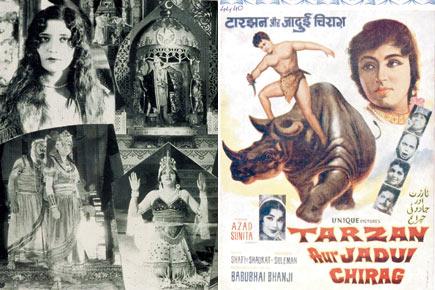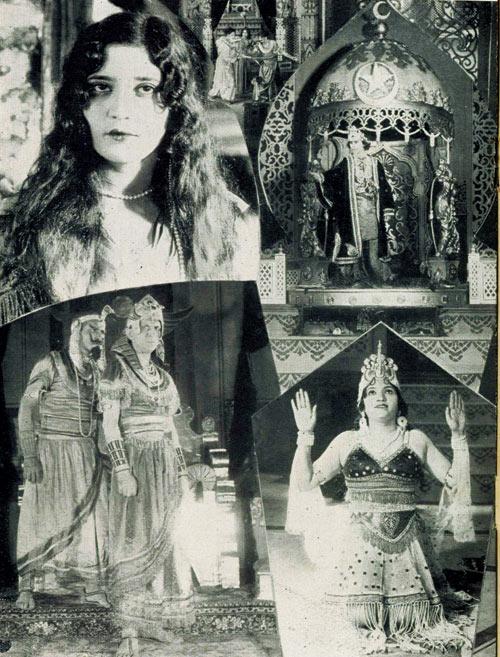A new collection of song-booklets at the National Film Archive of India traces the evolution of Bollywood through the ages


A leaf from the song-booklet of Bag-e-Misar (1934) directed by Wadia Brothers, the famous duo who gave us Hunterwali. PICS/NFAI
 If you Google for the film Bag-e-Misar, a 1934 production by the noted Wadia Brothers, the chances that you will get a synopsis and cast information is close to none. Digital traces indicate the bare minimum — that the film existed and featured Feroze Dastur and Padma, among others.
If you Google for the film Bag-e-Misar, a 1934 production by the noted Wadia Brothers, the chances that you will get a synopsis and cast information is close to none. Digital traces indicate the bare minimum — that the film existed and featured Feroze Dastur and Padma, among others.
ADVERTISEMENT
However, a recent acquisition by the National Film Archive of India (NFAI), Pune, could change that. Turns out that Bag-e-Misar follows a tussle between royalty across Damascus and Misar (in present day Iran). There is also Ariana, a court dancer in the Temple of Isis, played by Miss Jamna. All these and more in a 21-page song-booklet of Bag-e-Misar, now available at the NFAI.

The cover of the song-booklet of Tarzan aur Jadui Chirag (1966)
“This song-booklet is the oldest in the recent collection that has come to us from a private collector,” says Prakash Magdum, director of the NFAI. In June this year, the NFAI acquired 1,790 such song-booklets — what Magdum calls ‘a valuable addition’ to the NFAI’s existing collection of 15,000. What makes this most recent acquisition noteworthy is that it chronicles every decade of Bollywood, right from 1934 to 2012.
Song-booklets may sound a lot like songbooks, but contain more than just lyrics. They have photos, illustrations and advertisements, and were meant to be distributed before or during the screening of a movie. “Song-booklets provided a full list of cast and crew, making them important archival material, especially for rare films,” says Magdum, drawing our attention to a the booklet of Hatim Tai Ki Beti, a 1955 production which is no longer available in the film format.
The oldest song-booklet at the NFAI is that of Sinhagad, V Shantaram’s Marathi historical drama made in 1933. Magdum points out to similar vintage booklets in this new collection. “There may be several such movies that have been lost, but which we can know about only through the existence of these booklets, which also give the plot summary,” he continues.
Take the case of Bag-e-Misar’s song-booklet. It is replete with film stills and a synopsis of the plot in English, Hindi, Urdu and Gujarati. There are quaint advertisements too, such as one of Godrej’s Vegetable Toilet Soaps. In this time capsule available in the form of song-booklets, Magdum notes interesting aspects, such as scribbles in the margins and readers marking their favourite songs.
Rafique Baghdadi, a Mumbai-based film historian who owns song booklets from BR Chopra’s and Mehboob Khan’s films, says that the interest in songbooks, like other film memorablia, is recent, just a decade old even. He distinguishes song-booklets into two categories — there were those given away for free, which meant they had sub-standard writing and lettering, and there were those that were sold for about five annas. These had more sophistication, naturally. From the look of it, the new addition to NFAI seems to be the latter.
Among production houses that promoted a number of these songbooks, Baghdadi says, Bombay Talkies led the line. In the recent NFAI collection, the Wadia Brothers top the list. He adds that along with lobby cards, these booklets form important archival and research material. “These booklets usually advertise forthcoming films; whether the production house actually made them or not was completely a different matter,” says Baghdadi. Wadia Brothers made good use of the back cover of Bag-e-Misar, announcing their 1934-35 schedule: Vaman Avtar (a chapter from Hindu mythology), Kaumi Delair (story of the Fall of Babylon), Arya Mahila (a social melodrama) and so on. Go ahead and Wiki these; see if you find them.
The collection also has pamphlets, such as that of Spy in Rome, a 1968 Bollywood thriller, splashed with illustrations and photographs. It comes with some choice statements, like: All world famous monuments filmed to make this movie monumental. With guns and gals all over, it could have been easily mistaken for a Bond flick, Magdum says.
The NFAI will begin digitising these new additions to the song booklets in about a month’s time. However, to view the booklets in person, the public will have to wait for one of NFAI’s exhibitions. “These are not just entertainment material but also important from the point of view of research. We want to allow people access to our collection,” he says.
 Subscribe today by clicking the link and stay updated with the latest news!" Click here!
Subscribe today by clicking the link and stay updated with the latest news!" Click here!







